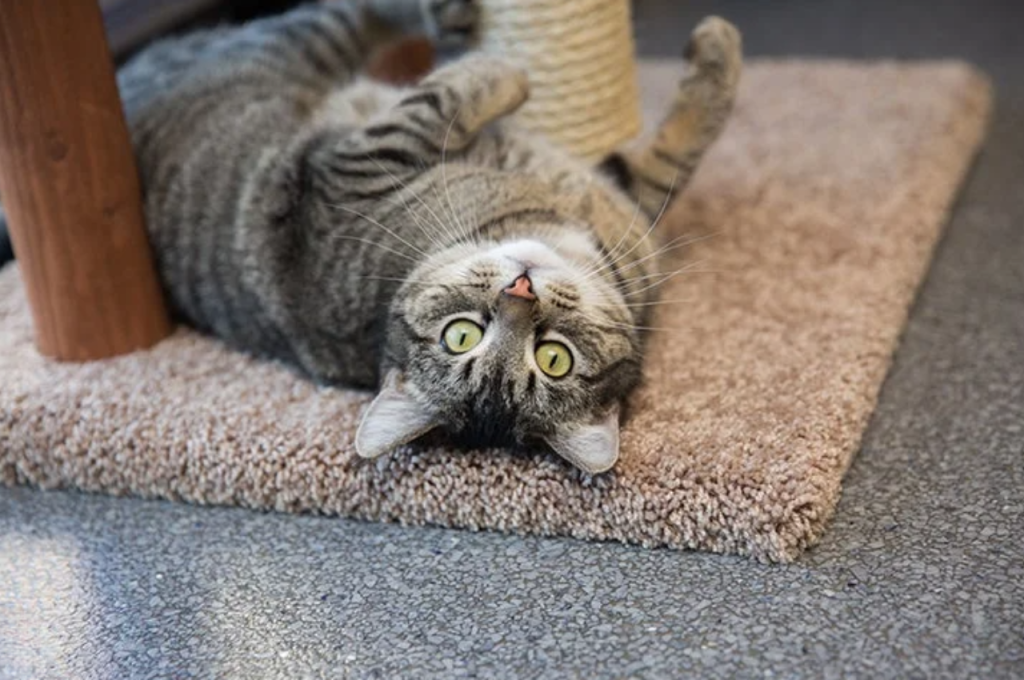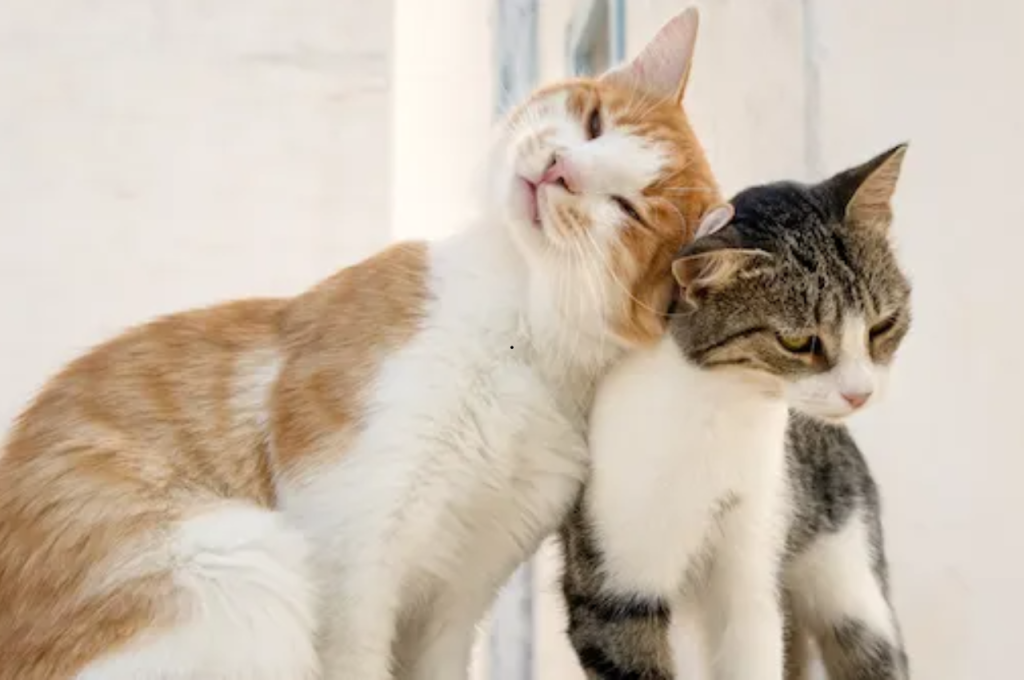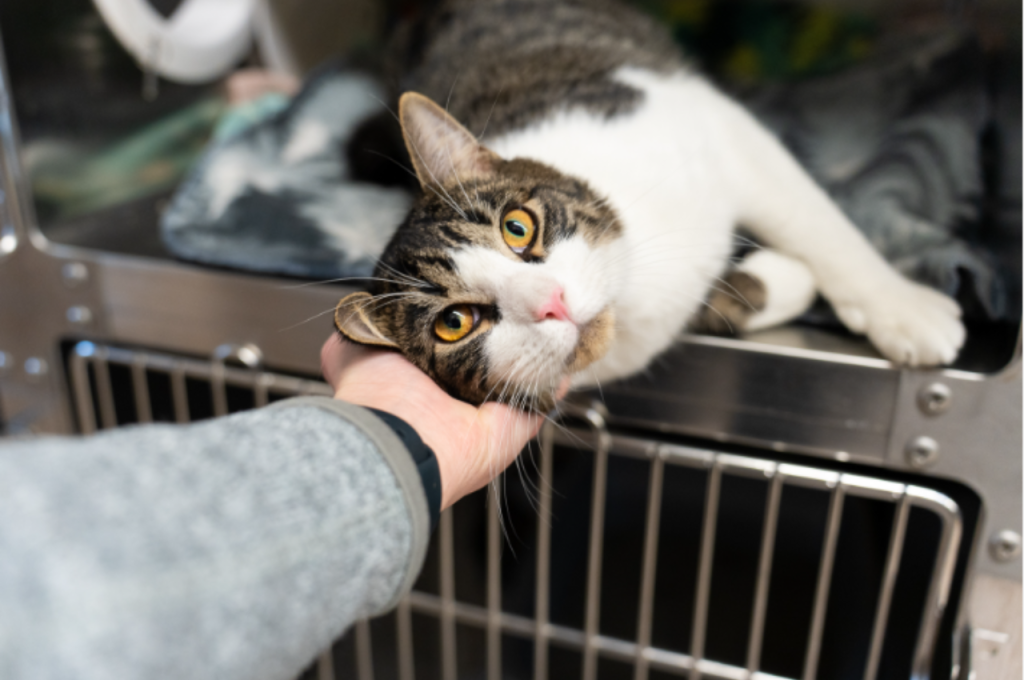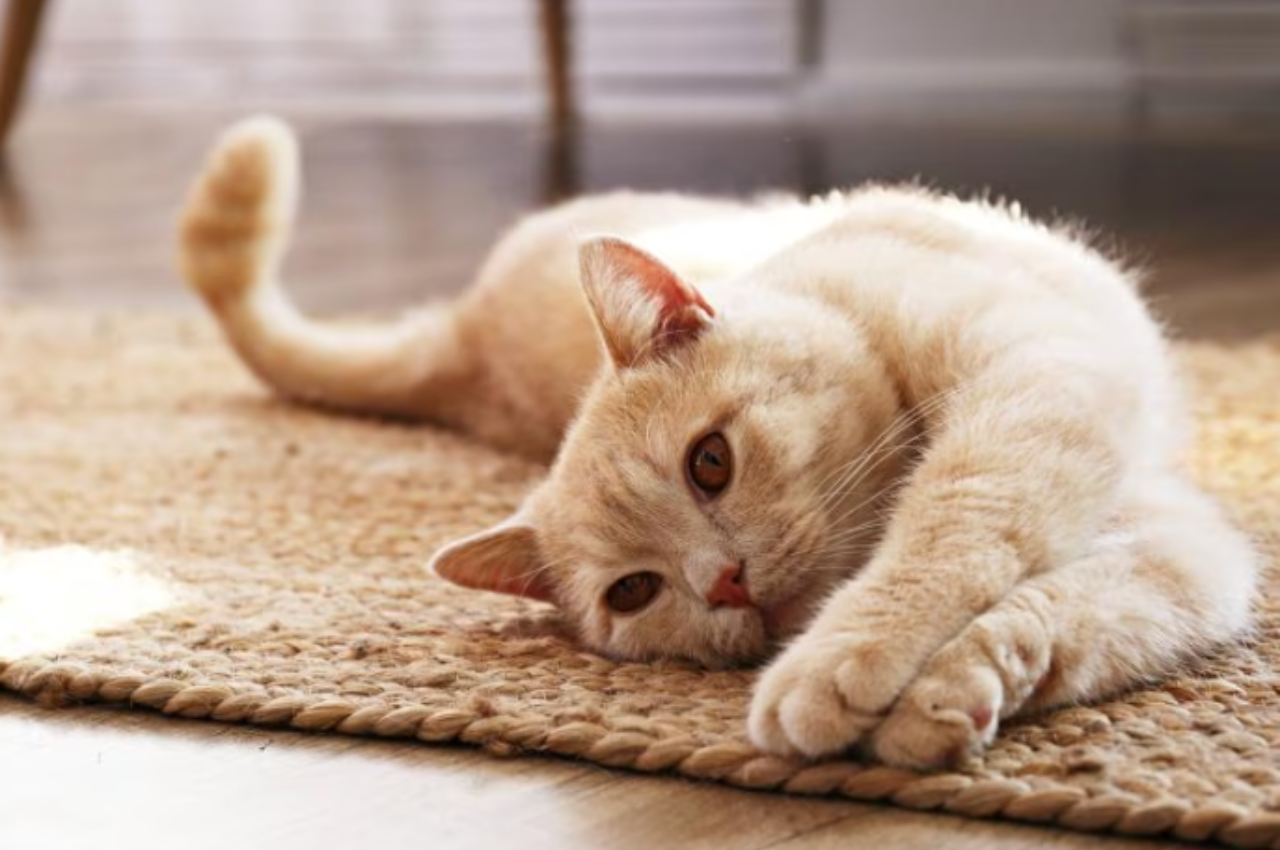A friendly body language for cats includes slow blinking, relaxed ears, and a calm posture. These signals can help establish a positive relationship between cats and their owners.
Cats are known for their independent and aloof nature, but they also crave affection and attention from their owners. By understanding their body language, owners can create a bond with their feline friends. Slow blinking is a sign of trust and relaxation in cats. When a cat’s ears are relaxed and not flattened, it indicates a calm and comfortable state. A cat’s body posture can also convey their mood. A relaxed and open posture shows a friendly and confident cat, while a tense or hunched posture indicates fear or aggression. By paying attention to these signals, owners can communicate effectively with their cats and establish a strong and loving relationship.
Introduction to Feline Body Language
Discovering a cat’s friendly body language involves observing relaxed posture, slow blinking, and gentle tail movements. These signals indicate comfort and trust, showcasing a cat’s content and approachable demeanor. Understanding these cues fosters better communication and strengthens the human-feline bond. Cats communicate through body language, an essential aspect of understanding their needs and emotions.

Why It’s Essential
Understanding cat body language helps strengthen the bond between you and your pet.
Basics Every Cat Owner Should Know
- The tail position indicates mood and comfort level.
- Ears forward show interest, backward signal agitation.
- Purring signifies contentment.
The Tail Tells The Tale
When it comes to understanding a cat’s body language, one of the most important indicators is their tail. Cats use their tails to communicate a range of emotions and intentions, allowing us to better understand their needs and desires. In this article, we will explore the various messages a cat’s tail can convey and how to interpret them.
Tail Up: Confidence and Contentment
A cat with its tail held high is a sign of confidence and contentment. When a cat is feeling comfortable and secure in its environment, it will often hold its tail upright. This position allows them to show off their confidence and assertiveness. It signifies that the cat is in a positive state of mind and open to social interaction.
The Question Mark: Curiosity
When a cat’s tail is curved like a question mark, it indicates curiosity and interest. This position is often seen when a cat is exploring its surroundings or investigating something new. The cat’s tail acts as an extension of its curiosity, showing its eagerness to explore and discover. It is important to allow the cat to satisfy its curiosity by providing a safe and enriching environment.
Tail Wrapped Around Feet: Comfort and Security
When a cat wraps its tail around its feet, it signifies a sense of comfort and security. This behavior is commonly seen when a cat is relaxed and at ease. By wrapping its tail around its body, the cat is creating a protective barrier and seeking warmth and comfort. It is a clear indication that the cat feels safe in its environment and trusts its surroundings.
Understanding a cat’s body language, particularly their tail movements, can greatly enhance our relationship with our feline companions. By paying attention to these subtle cues, we can better meet their needs and ensure their well-being. Remember to observe your cat’s tail position in different situations and environments, as it can provide valuable insights into their emotional state.
Eyes Wide Open to Feline Feelings
Cats communicate a wide range of emotions through their body language. Understanding their visual cues, particularly through their eyes, can help us decipher their feelings and respond appropriately to their needs.
Slow Blinking: Trust and Affection
When a cat engages in slow blinking, it signifies trust and affection. This action is akin to a cat’s way of saying “I feel safe with you.” Returning the slow blink can strengthen the bond between you and your feline friend, conveying a message of mutual trust and comfort.
Dilated Pupils: Excitement or Anxiety
Dilated pupils in cats can indicate either excitement or anxiety. While excitement may be displayed when a cat is engaged in play or encounters something stimulating, anxiety can lead to dilated pupils as well. It’s crucial to observe the overall body language to accurately interpret the cause of the dilation.
Whisker Wisdom
When it comes to communicating with cats, understanding their body language is key. Cats use various signals to express their emotions and intentions, and one important aspect of their body language is their whiskers. Cats’ whiskers, also known as vibrissae, serve as sensory organs that help them navigate their surroundings and communicate with other cats and humans. By paying attention to their whiskers and the way they position them, you can gain valuable insights into a cat’s mood and intentions.
Forward Facing: Interest and Excitement
When a cat’s whiskers are forward-facing, it is a sign of interest and excitement. Just like humans raise their eyebrows when they are intrigued, cats push their whiskers forward when they are curious or focused on something. This forward-facing position indicates that the cat is engaged and actively exploring its environment. You may observe this whisker position when your cat is watching birds outside the window or when they are about to pounce on a toy. It’s important to note that a cat with forward-facing whiskers is generally in a positive and receptive state.
Pulled Back: Stress or Fear
On the other hand, when a cat’s whiskers are pulled back against its face, it is a clear sign of stress or fear. Cats instinctively pull back their whiskers when they feel threatened or anxious. This defensive position helps protect their delicate whiskers from harm. If you notice your cat’s whiskers pulled back tightly against its face, it is essential to assess the situation and identify the source of stress. It could be caused by a loud noise, unfamiliar visitors, or even a confrontation with another animal. By recognizing this body language, you can take steps to create a calmer and safer environment for your feline companion.
In addition to their whiskers, cats communicate their emotions through other body language cues such as their tail position, ear posture, and vocalizations. By observing and understanding these signals, you can build a stronger bond with your cat and ensure their well-being. Remember that each cat is unique, so it’s important to familiarize yourself with your cat’s individual body language patterns and preferences.
In conclusion, whisker wisdom is a powerful tool in deciphering a cat’s emotions and intentions. By paying attention to the position of their whiskers, you can gauge their level of interest, excitement, stress, or fear. This understanding will enable you to provide the appropriate care and support your feline friend needs to thrive.
Ears: Tuning Into Their Mood
Cats communicate through their body language, and their ears play a crucial role in expressing their mood. Friendly cats often have relaxed ears that are pointed slightly forward, showing their interest and openness to interaction. Understanding their body language can help create a positive and comfortable environment for cats. Ears are a crucial indicator of a cat’s mood and feelings. Understanding their ear positions can help you communicate better with your feline friend.

Ears Forward: Alert and Content
When a cat’s ears are forward, it signifies that they are feeling alert and content. This position shows that your cat is relaxed and comfortable in their environment.
Ears Flattened: Fear or Aggression
On the other hand, flattened ears indicate feelings of fear or aggression. When a cat’s ears are flattened against their head, it’s a sign that they are agitated or feeling threatened. Knowing how to interpret your cat’s ear positions can help you respond appropriately to their emotions and maintain a positive relationship with your furry companion.
The Vocal Cat: Understanding Meows and Purrs
Cats express friendliness through a relaxed body posture, such as a softly swaying tail and slow blinking. They may also approach with a straight, raised tail and rub their head against you. Understanding these cues can help foster a positive relationship with your feline friend.
Deciphering The Meow
Cats are known for their unique vocalizations and meowing is one of their primary ways of communicating with humans. However, it can be challenging to understand what your feline friend is trying to convey through their meows. Generally, a short, high-pitched meow means a greeting or a request for attention, while a long, drawn-out meow may indicate frustration or discomfort. Additionally, the pitch, tone, and volume of meow can also give you clues about your cat’s emotions and needs.
Purring: More Than Just Contentment
Cats purr when they’re content, but that’s not the only time they use this vocalization. Purring can also be a sign of pain, fear, or stress. It’s important to pay attention to your cat’s body language and other vocalizations to determine the context of their purring. For example, if your cat is purring while their ears are flat and their body is tense, they may be experiencing discomfort or anxiety. When it comes to understanding your cat’s vocalizations, it’s essential to pay attention to their body language and other cues.
By deciphering your cat’s meows and purrs, you can better understand their emotions and needs. Remember that every cat is unique, and their vocalizations may vary based on their personality and individual experiences. By spending time getting to know your feline friend, you’ll be able to develop a deeper understanding of their communication style.
Physical Contact and Bonding
Physical contact is an essential part of bonding with your cat. Understanding their body language and knowing how to respond appropriately can help strengthen your relationship with your feline friend. When it comes to physical contact and bonding, certain behaviors like head bunting and kneading can signify affection and trust, as well as comfort and contentment.
Head Bunting: Affection and Trust
Head bunting, where a cat gently bumps its head against you, is a sign of affection and trust. This behavior is a way for cats to exchange scents and create a sense of familiarity. When your cat’s head bunts you, acknowledge their gesture by gently petting them and reciprocating the interaction.
Kneading: Comfort and Contentment
Kneading, often observed as a rhythmic pressing motion with their paws, is a behavior that stems from kittenhood. Cats knead when they feel comfortable and content, as it’s a soothing and self-soothing behavior. Understanding that your cat is expressing happiness and relaxation through kneading can help you respond with affection and create a deeper bond.
Reading The Room: Group Dynamics Among Cats
When it comes to understanding cats, it’s essential to recognize the significance of body language. Reading the Room: Group Dynamics Among Cats sheds light on how cats communicate with each other through non-verbal cues. By understanding the social hierarchy, play dynamics, and aggression signals, cat owners can better interpret their pets’ behavior.
The Social Hierarchy
Cats have a complex social structure, often establishing a hierarchy within their groups. The dominant cat typically claims the best resting spots and food sources, while subordinate cats yield to their authority. Understanding this hierarchy can help cat owners manage multi-cat households and prevent conflicts.
Play Versus Aggression
Play and aggression can sometimes be mistaken for one another in cat interactions. It’s important to differentiate between the two to ensure a harmonious environment. Playful behaviors, such as chasing and pouncing, are typically accompanied by loose, relaxed body language. Aggressive behaviors, on the other hand, involve stiff postures, flattened ears, and hissing.
Practical Tips for Positive Interaction
Cats communicate through body language, and understanding their friendly cues is essential for positive interaction. To create a welcoming atmosphere, maintain an open posture, avoid direct eye contact, and offer slow, gentle movements. Observing their tail position and ear orientation can also provide valuable insights into their mood.
Practical Tips for Positive Interaction
Cats have a unique way of communicating, and their body language plays an important role in it. It’s crucial for cat owners to understand their feline friend’s body language to ensure a positive interaction. Here are some practical tips for positive interaction with your cat:
Respecting Boundaries
Cats are independent creatures and value their personal space. It’s important to respect their boundaries and give them space when they need it. When interacting with your cat, make sure to approach them slowly and calmly. Avoid sudden movements or loud noises that can startle them. If your cat starts to show signs of discomfort, such as hissing or growling, back away and give them some space.
Encouraging Friendly Behavior
Cats love attention and affection, but they also enjoy their alone time. To encourage friendly behavior, offer your cat treats and playtime to reinforce positive interactions. When your cat approaches you, offer them a gentle petting or scratch behind the ears. If they seem disinterested, don’t force them to interact. Respect their decision and try again later.

Here are some additional tips for encouraging friendly behavior:
- Use positive reinforcement techniques, such as treats and praise, to reward good behavior.
- Avoid punishment, as it can cause fear and anxiety in your cat.
- Provide a safe and comfortable environment for your cat to explore and play.
In conclusion, understanding your cat’s body language is crucial for positive interaction. By respecting their boundaries and encouraging friendly behavior, you can build a strong bond with your feline friend.
Conclusion
Understanding and using friendly body language can help you bond with your feline friend. By respecting their space and being attentive to their cues, you can create a positive and comfortable environment for your cat. Pay attention to their body language and respond accordingly to build a strong and trusting relationship.
